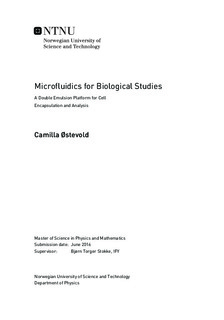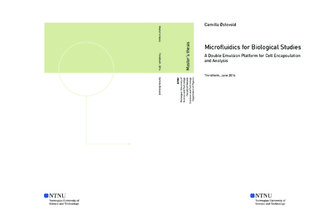| dc.description.abstract | Encapsulation of biologicalmaterial in small, confined volumes has enabled the study
of individual cells, revealing valuable and detailed information on cellular processes and
behavior unavailable in traditional bulk studies. This work presents a double emulsion
platform for the encapsulation and analysis of biological material. Double emulsions
were synthesized in 3D microfluidic PDMS devices and immobilized on PDMS microarrays
for imaging purposes. The effect of flowrates on droplet sizes and amount of double
emulsion cores was explored, however, no definite relationship was determined due to
variations in the system. The origin of these variations was probably device alignment,
surface treatment, the tubing of the syringe pump system, or a combination thereof. The
fluorosurfactant provided by SMaL at EPFL rendered the double emulsions stable with
regards to coalescence, temperature variations, and shear forces exerted by the carrier
fluid. The greatest challenge in terms of stability appeared to be osmotic pressure differences between the double emulsion cores and the surrounding medium. However, it is
likely that this obstacle can be overcome by a thoroughmeasurement of the osmolarities
of the inner and outer phases and subsequent balancing of possible differences by the
addition of sucrose. Double emulsion cores containing 0.60%, high G-content alginate
(Mw = 275 kDa) and chelated calcium ions were gelated for the synthesis of spherical,
micron-sized hydrogels. Two different internal gelation methods were investigated; pHtriggered
gelation and a novel gelation method recently established at NTNU termed CLEX. Both successfully synthesized hydrogels, however, CLEX is favorable for biological
systems as it occurs at neutral pH-values. Additionally, a device with two inner phase
inlets was applied for gelation of alginate cores by CLEX. This device introduces the possibility of on-chip mixing of double emulsion cargo, which may be utilized for studies
of cellular processes such as bacterial conjugation. Pseudomonas Putida and Chlamydomonas
reinhardtiiwere encapsulated on-chipwith high throughput, resulting in compartmentalization
of single or few cells in suitable microenvironments. Three different encapsulation media were tested for their compatibility with a droplet-based microfluidic system and living material; 20% PEG, 0.60% and 0.15% alginate. The latter provided a viable and healthy microenvironment for cell growth. Double emulsions with 0.15% alginate cores and the microarray thus represent a suitable platformfor microbiological studies if the osmotic instability issue is resolved. | |

